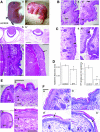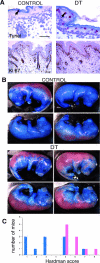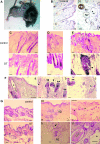Targeted skin overexpression of the mineralocorticoid receptor in mice causes epidermal atrophy, premature skin barrier formation, eye abnormalities, and alopecia
- PMID: 17675581
- PMCID: PMC1959477
- DOI: 10.2353/ajpath.2007.060991
Targeted skin overexpression of the mineralocorticoid receptor in mice causes epidermal atrophy, premature skin barrier formation, eye abnormalities, and alopecia
Abstract
The mineralocorticoid receptor (MR) is a transcription factor of the nuclear receptor family, activation of which by aldosterone enhances salt reabsorption in the kidney. The MR is also expressed in nonclassical aldosterone target cells (brain, heart, and skin), in which its functions are incompletely understood. To explore the functional importance of MR in mammalian skin, we have generated a conditional doxycycline-inducible model of MR overexpression, resulting in double-transgenic (DT) mice [keratin 5-tTa/tetO-human MR (hMR)], targeting the human MR specifically to keratinocytes of the epidermis and hair follicle (HF). Expression of hMR throughout gestation resulted in early postnatal death that could be prevented by antagonizing MR signaling. DT mice exhibited premature epidermal barrier formation at embryonic day 16.5, reduced HF density and epidermal atrophy, increased keratinocyte apoptosis at embryonic day 18.5, and premature eye opening. When hMR expression was initiated after birth to overcome mortality, DT mice developed progressive alopecia and HF cysts, starting 4 months after hMR induction, preceded by dystrophy and cycling abnormalities of pelage HF. In contrast, interfollicular epidermis, vibrissae, and footpad sweat glands in DT mice were normal. This new mouse model reveals novel biological roles of MR signaling and offers an instructive tool for dissecting nonclassical functions of MR signaling in epidermal, hair follicle, and ocular physiology.
Figures






Similar articles
-
The mineralocorticoid receptor as a novel player in skin biology: beyond the renal horizon?Exp Dermatol. 2010 Feb;19(2):100-7. doi: 10.1111/j.1600-0625.2009.01011.x. Epub 2009 Nov 18. Exp Dermatol. 2010. PMID: 19925636 Review.
-
Expression and function of the human mineralocorticoid receptor: lessons from transgenic mouse models.Mol Cell Endocrinol. 2004 Mar 31;217(1-2):127-36. doi: 10.1016/j.mce.2003.10.045. Mol Cell Endocrinol. 2004. PMID: 15134811 Review.
-
Development and progression of alopecia in the vitamin D receptor null mouse.J Cell Physiol. 2006 May;207(2):340-53. doi: 10.1002/jcp.20578. J Cell Physiol. 2006. PMID: 16419036
-
Conditional epidermal expression of TGFbeta 1 blocks neonatal lethality but causes a reversible hyperplasia and alopecia.Proc Natl Acad Sci U S A. 2001 Jul 31;98(16):9139-44. doi: 10.1073/pnas.161016098. Proc Natl Acad Sci U S A. 2001. PMID: 11481479 Free PMC article.
-
Activation of Notch1 in the hair follicle leads to cell-fate switch and Mohawk alopecia.Differentiation. 2004 Oct;72(8):396-409. doi: 10.1111/j.1432-0436.2004.07208006.x. Differentiation. 2004. PMID: 15606499
Cited by
-
Glucocorticoid receptors, epidermal homeostasis and hair follicle differentiation.Dermatoendocrinol. 2011 Jul;3(3):166-74. doi: 10.4161/derm.3.3.15332. Epub 2011 Jul 1. Dermatoendocrinol. 2011. PMID: 22110775 Free PMC article.
-
Roles of the Glucocorticoid and Mineralocorticoid Receptors in Skin Pathophysiology.Int J Mol Sci. 2018 Jun 29;19(7):1906. doi: 10.3390/ijms19071906. Int J Mol Sci. 2018. PMID: 29966221 Free PMC article. Review.
-
A Systematic Review of Spironolactone Nano-Formulations for Topical Treatment of Skin Hyperandrogenic Disorders and Chronic Wounds.Pharmaceutics. 2024 Dec 27;17(1):27. doi: 10.3390/pharmaceutics17010027. Pharmaceutics. 2024. PMID: 39861676 Free PMC article. Review.
-
Severity of Alopecia Predicts Coronary Changes and Arterial Stiffness in Untreated Hypertensive Men.J Clin Hypertens (Greenwich). 2017 Jan;19(1):51-57. doi: 10.1111/jch.12871. Epub 2016 Jul 1. J Clin Hypertens (Greenwich). 2017. PMID: 27365213 Free PMC article.
-
The myeloid mineralocorticoid receptor regulates dermal angiogenesis and inflammation in glucocorticoid-induced impaired wound healing.Br J Pharmacol. 2022 Dec;179(23):5222-5232. doi: 10.1111/bph.15932. Epub 2022 Sep 2. Br J Pharmacol. 2022. PMID: 35861949 Free PMC article.
References
-
- Schmidt-Ullrich R, Paus R. Molecular principles of hair follicle induction and morphogenesis. Bioessays. 2005;27:247–261. - PubMed
-
- Stenn KS, Paus R. Controls of hair follicle cycling. Physiol Rev. 2001;81:449–494. - PubMed
-
- Alonso LC, Rosenfield RL. Molecular genetic and endocrine mechanisms of hair growth. Horm Res. 2003;60:1–13. - PubMed
-
- Calléja C, Messaddeq N, Chapellier B, Yang H, Krezel W, Li M, Metzger D, Mascrez B, Ohta K, Kagechika H, Endo Y, Mark M, Ghyselinck NB, Chambon P. Genetic and pharmacological evidence that a retinoic acid cannot be the RXR-activating ligand in mouse epidermis keratinocytes. Genes Dev. 2006;20:1525–1538. - PMC - PubMed
Publication types
MeSH terms
Substances
LinkOut - more resources
Full Text Sources
Other Literature Sources
Medical
Molecular Biology Databases
Research Materials
Miscellaneous

